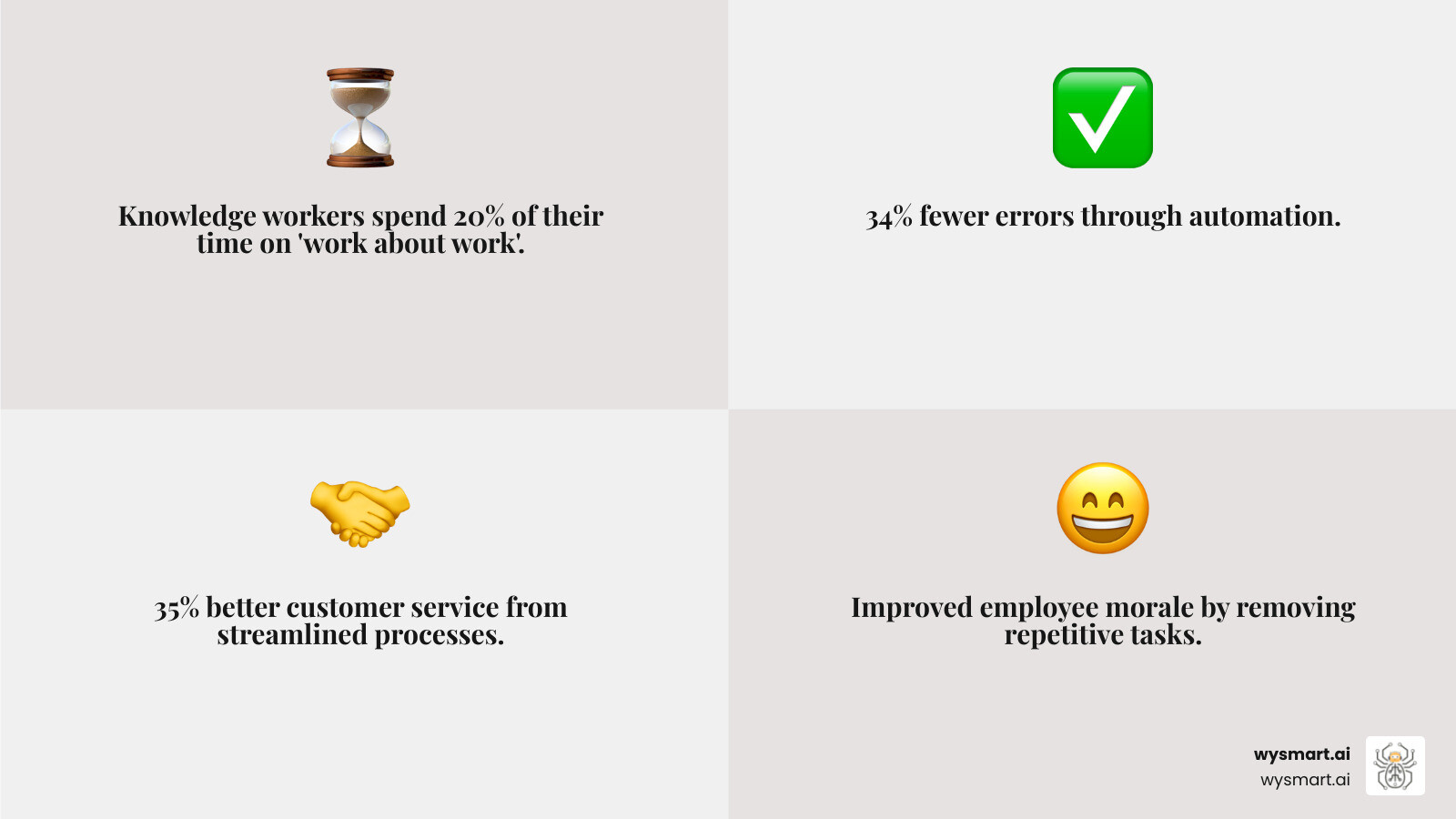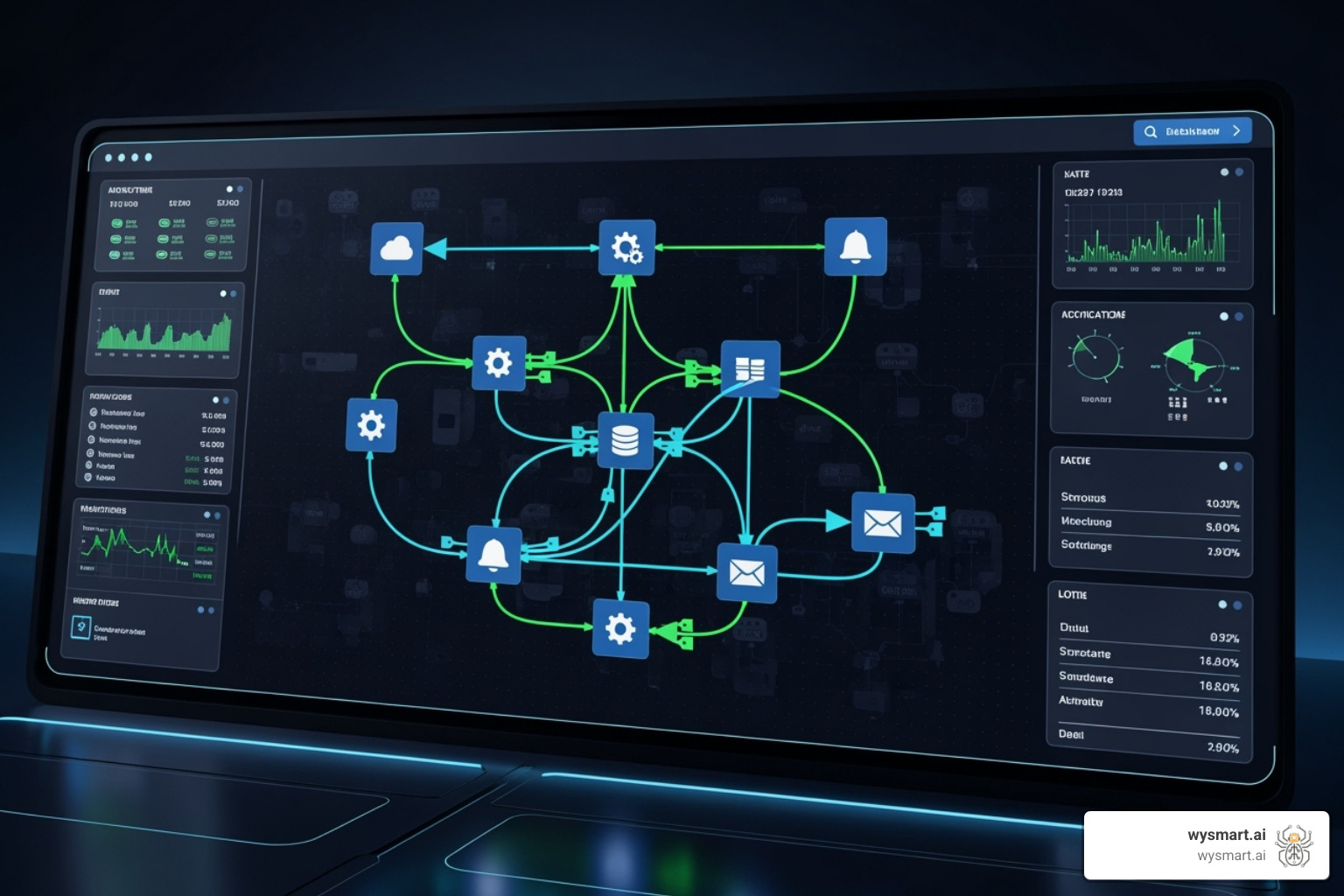
Why Business Efficiency Starts with Streamlined Operations
Streamline processes and workflows is the key to open uping your business potential, yet most small business owners remain trapped in cycles of inefficient work. According to McKinsey research, knowledge workers spend nearly 20% of their time looking for internal information or tracking down colleagues who can help with specific tasks - that's a full day each week lost to "work about work."
Quick Answer: How to Streamline Processes and Workflows
Map current processes - Document how work actually gets done today
Identify bottlenecks - Find where delays and inefficiencies occur
Eliminate redundancies - Remove unnecessary steps and duplicate work
Automate repetitive tasks - Use technology for routine activities
Monitor and refine - Track results and continuously improve
The impact of streamlined operations goes far beyond saving time. Companies report 34% fewer errors through automation, while 35% provide better customer service when manual tasks are eliminated. For small business owners juggling customer acquisition, retention, and daily operations, streamlining isn't just helpful - it's essential for survival and growth.
Why This Matters for Your Business
Reduced costs from eliminated waste and faster completion times
Higher productivity when employees focus on valuable work instead of busywork
Better customer experience through consistent, reliable processes
Improved employee morale by removing frustrating, repetitive tasks
Competitive advantage through operational excellence
I'm Joey Martin, founder of WySMart.ai, and I've spent years helping small business owners streamline processes and workflows to reduce overhead while boosting revenue. After watching countless businesses struggle with inefficient operations that drain time and resources, I've developed proven systems that work without requiring you to become a process expert overnight.

What is Process Streamlining and Why is it Crucial for Your Business?
Picture this: you're trying to steer a busy city with no street signs, traffic lights that change randomly, and roads that suddenly dead-end without warning. Frustrating, right? That's exactly what running a business with unstreamlined processes feels like every single day.
Process streamlining is the art and science of taking your existing business operations and making them work better, faster, and with less headache for everyone involved. It's about creating clear, efficient pathways for work to get done.
Want a deeper historical perspective? Check out the Wikipedia overview of Business process management for additional context on how structured process improvement evolved.
Let's break this down. A process is a step-by-step recipe for a task, like onboarding a new customer. A workflow is how that recipe is executed—who does what, when, and how work moves from one person to the next.
When you streamline processes and workflows, you become a business efficiency detective. You hunt for bottlenecks where work gets stuck, redundancies where people do the same thing twice, and communication gaps where information gets lost. The goal isn't to make your team work harder—it's to make their work matter more.

The Compelling Benefits of Streamlined Operations
When you successfully streamline processes and workflows, the benefits ripple across your entire business.
Productivity skyrockets as your team stops wasting time on busywork and focuses on tasks that grow the business.
Costs drop significantly by eliminating waste. Less time on redundant tasks and fixing errors means lower labor and operational costs.
Quality improves dramatically because standardized processes lead to consistent, reliable outcomes. Customers get the same great experience every time.
Employee morale gets a huge boost. Removing frustrating, inefficient systems makes work more satisfying and less stressful.
Customers notice the difference through faster response times, fewer errors, and consistent service, leading to higher satisfaction and loyalty.
For example, 34% of companies reduce errors with automation, which is often a key part of streamlining efforts. When you automate repetitive tasks like data entry, human errors virtually disappear.
Here's a real-world example that shows the power of streamlining:
| Feature | Manual Employee Onboarding Process | Streamlined, Automated Employee Onboarding Process | | Time (for process) | ~1.5 hours per employee | ~15 minutes per employee | | Steps | 20+ manual steps (forms, emails, sign-offs, copies) | 5-7 automated steps (digital forms, automated notifications, e-signatures) | | Errors | High potential for human error (missed forms, incorrect data entry, lost documents) | Minimal human error (data validation, automated routing) | | Employee Experience | Tedious, overwhelming, disjointed | Smooth, efficient, welcoming | | HR Time Saved | Significant manual administrative burden | Reduced administrative burden, more time for strategic HR |
Common Challenges to Avoid
Streamlining isn't always smooth sailing. Here are common pitfalls to watch for:
Resistance to change: People are comfortable with routines. Involve your team early and communicate the benefits to them directly.
Lack of clear goals: Without specific goals (e.g., "reduce processing time by 50%"), your efforts will lack focus and measurable success.
Neglecting documentation: Undocumented processes are easily forgotten or lost when team members leave. Document your new workflows.
Focusing on symptoms instead of root causes: Don't just patch a slow step; dig deeper to understand why it's slow to find a lasting solution.
Choosing the wrong technology: Select tools that solve your specific problems and integrate with your existing systems, not just popular ones.
Scope creep: Start with clear boundaries. Resist the temptation to solve every problem at once, which can derail the project.
Insufficient training: A brilliant new process will fail if your team doesn't know how to use it. Plan for comprehensive training and support.
Your 5-Step Blueprint to Streamline Processes and Workflows
Ready to roll up our sleeves? We've developed a practical, 5-step blueprint to help us streamline processes and workflows. This is a journey of continuous improvement, not a one-time fix.
Step 1: Map and Identify Your Current Processes
Before we can improve something, we need to understand it. This step is about getting a clear picture of how things actually get done today.
Process Mapping: Visually map current processes with flowcharts to see every step and hand-off. This often reveals surprising complexities.
Identify Bottlenecks: As you map, look for points where work consistently slows down, piles up, or gets stuck.
Task Inventory: For each process, list all tasks, who performs them, and how long they take to find time-consuming "busywork."
Talk to Your Team: Your team has the clearest insights into what's slowing them down. Ask for their feedback on frustrations and redundancies.
Use Visual Project Management Tools: Tools with to-do lists, assignments, and due dates can help visualize and track current processes.
Analyze Activity Logs: For digital workflows, activity logs provide data-driven insights into where delays occur.
Step 2: Analyze, Prioritize, and Set Goals
Once we've mapped our processes, it's time to decide what to fix first. Prioritization is key.
Gather Feedback: Continue collecting feedback from your team and clients to identify the most significant pain points.
Data Analysis: Look at the data from Step 1. Which tasks take too long? Where are error rates high? Analyze the costs of current inefficiencies.
Identify Inefficiencies: Scrutinize each step and ask, "Does this add value?" If not, it's a candidate for elimination.
Prioritize High-Impact Processes: Rank processes by which ones cause the most pain or cost the most money. Start with the highest-impact areas.
Set SMART Goals: Define specific, measurable, achievable, relevant, and time-bound (SMART) goals, like "Reduce onboarding time by 30% this quarter."
Define Key Performance Indicators (KPIs): Establish metrics like cycle time, error rates, or customer satisfaction scores to track success.
Step 3: Redesign the Workflow and Standardize
This is where we design the "new and improved" version of our processes to be as lean and effective as possible.
Eliminate Unnecessary Steps: Ruthlessly cut any steps that are redundant or don't add value to the final outcome.
Simplify Tasks: Break down complex processes into smaller, more manageable tasks. Each step should be a single, clear action.
Standardize Procedures: Create clear, consistent procedures for repeatable tasks to ensure everyone performs them the same optimal way.
Create Document Templates: Develop templates for common documents like proposals or reports to speed up creation and maintain quality.
Use Checklists: For critical sequences, implement checklists to ensure no steps are missed.
Develop Project Specs and Content Calendars: For project-based work, clear specs and calendars standardize the process and ensure consistency.
Step 4: Implement Changes and Train Your Team
A great workflow is useless if it's not adopted. This step focuses on bringing new processes to life.
Gradual Rollout (Pilot Testing): Test the new workflow with a small group or project first to identify issues before a full rollout.
Clear Communication: Involve stakeholders early and explain the why behind the changes to build support and address concerns.
Provide Training: Offer comprehensive training on new processes and tools through videos, guides, or in-person sessions.
Address Concerns: Listen actively to feedback during implementation. Addressing concerns openly helps build buy-in.
Ensure Stakeholder Buy-in: When key individuals support the new workflows, adoption becomes much easier.
Document the New Process in a Central Location: Make new workflow documentation easily accessible to everyone to serve as a reference and speed up adoption.
Step 5: How to measure the success of your efforts to streamline processes and workflows
Our work isn't done after implementation. This final step is about continuous improvement.
Monitor KPIs: Regularly track the KPIs defined in Step 2 to see if you're meeting your goals. Is cycle time down? Are error rates lower?
Solicit Ongoing Feedback: Create channels for continuous feedback from your team. They use the processes daily and can offer valuable insights.
Refine and Optimize: Use KPI data and feedback to make adjustments. This is an iterative process of testing, learning, and improving.
Adaptability: Business environments change. Design processes that are flexible enough to adapt without major disruptions.
Long-term Sustainability: Embed continuous improvement into your company culture through consistent reinforcement and regular reviews.
Achieve Operational Excellence: By following these steps, you move towards operational excellence, where processes become a competitive advantage.
Leveraging Technology and Automation for Peak Efficiency
You can't truly streamline processes and workflows in today's world without embracing technology and automation. It's the backbone that enables you to scale, eliminate manual work, and free up your team for strategic tasks that move the business forward.

How Technology Helps Streamline Processes and Workflows
Technology takes repetitive, rule-based tasks and handles them automatically—faster and more accurately.
Workflow automation software handles task assignments, notifications, approvals, and data routing, ensuring processes run consistently without manual follow-up.
Project management tools centralize project information, helping you manage tasks, track progress, and keep teams communicating effectively.
Centralized communication hubs bring team conversations into one organized space, eliminating information silos from scattered email threads.
Digital solutions for repetitive tasks like digital forms and e-signature platforms eliminate paper shuffling and speed up approvals.
Low-code and no-code platforms empower anyone on your team to build custom automation and workflows without needing to be a developer.
The Role of AI in Modern Streamlining
Artificial Intelligence takes automation to the next level by learning and making intelligent decisions about your workflows.
AI-powered process mining analyzes system logs to automatically identify hidden bottlenecks and inefficiencies that humans might miss.
Predictive analytics uses historical data to forecast future trends and potential problems, allowing you to be proactive.
AI-powered task management can suggest optimal task assignments based on team skills and workload, and prioritize work automatically.
AI assistants handle routine administrative tasks like scheduling meetings, retrieving information, and answering frequently asked questions.
Complex decision-making can be automated by AI, which can route inquiries, approve requests, and adjust workflows based on business rules.
Key Areas to Automate
Some business areas are prime candidates for automation to streamline processes and workflows.
Repetitive data entry: Automating data entry is the easiest way to reduce time-consuming, error-prone manual work. Companies that do so see a significant reduction in errors.
Customer follow-ups: Ensure timely and consistent communication with automated follow-up emails and lead nurturing sequences so no customer falls through the cracks.
Employee onboarding: Transform onboarding from a paper-chase into a smooth, professional experience with automated welcome emails, task assignments, and document collection.
Report generation: Automate the process of pulling data from various sources to create scheduled reports, giving your team real-time insights without the manual effort.
Task assignments and notifications: Use triggers like new leads or project milestones to automatically assign work and notify team members, keeping everyone informed.
Frequently Asked Questions about Streamlining Workflows
We get it - you probably have questions about how to streamline processes and workflows. Let's tackle the most common ones.
What is the difference between process streamlining and workflow automation?
People often confuse these two, but they work together. Process streamlining is the strategic act of redesigning a process to be simpler and more efficient. It's about finding a better way to do something, which can be done with or without technology.
Workflow automation is the tactical use of technology to execute the steps of that redesigned process automatically. First, you streamline the process to design the best path. Then, you automate it to ensure you take that path efficiently every time.
What is a simple, real-world example of a streamlined process?
Let's look at expense reporting.
The old, manual way: An employee manually types receipts into a spreadsheet, prints it, gets a physical signature from a manager, and submits it to finance for re-entry into the accounting system. The process is slow, error-prone, and can take weeks for reimbursement.
The streamlined, automated process: The employee uses an app to photograph receipts, and the data is extracted automatically. The report is submitted with one click, digitally routed for approval, and the data flows directly into the accounting system. Reimbursement happens in days, not weeks. The streamlined version is faster, more accurate, and less frustrating for everyone.
How often should we review our processes?
Processes aren't set in stone. We recommend a thorough review at least once or twice a year to catch inefficiencies before they become major problems.
You should also review processes whenever there's a significant business change, such as adopting new technology, restructuring a team, or shifting business goals. Pay attention to performance metrics—if tasks are taking longer or error rates are rising, it's time for a review.
Most importantly, listen to your team. Their daily frustrations often point directly to an inefficient process that needs attention. The goal is to build a culture of continuous improvement where you regularly streamline processes and workflows.
Conclusion: Achieve Effortless Efficiency and Sustainable Growth
What a journey we've been on together! We started by understanding what streamline processes and workflows really means, finded why it's absolutely crucial for business success, and walked through our practical 5-step blueprint. We've explored how technology and AI can transform the way we work, turning tedious tasks into smooth, automated processes.
But here's the thing - this isn't just about saving a few minutes here and there. When we take the time to streamline processes and workflows, we're fundamentally changing how our business operates. We're empowering our teams to focus on meaningful work instead of getting bogged down in busywork. We're improving our customer experience by delivering faster, more consistent service. Most importantly, we're building a more agile and resilient business that can adapt and grow.
Think about it: no more employees spending 20% of their time searching for information. No more frustrating bottlenecks that slow everything down. No more errors that could have been prevented with better processes. Instead, we get increased productivity, cost savings, happier employees, and delighted customers.
The future of work isn't about grinding harder - it's about working smarter. It's about removing the friction that holds us back and focusing our energy on what truly drives growth and innovation. We're not just organizing our current chaos; we're creating a foundation for sustainable success.
Continuous improvement should become part of our company DNA. As we implement these changes, we'll find new opportunities to optimize, new ways to serve our customers better, and new possibilities we never imagined.
For businesses ready to accept this change but feeling overwhelmed by where to start, comprehensive solutions exist. Platforms like WySmart.ai provide the AI-powered tools needed to automate marketing, sales, and operations - offering a complete, done-for-you approach to boost growth and reduce stress.
The choice is ours: we can keep letting inefficiencies drain our time, energy, and resources, or we can take action. We can accept the power of streamlined operations and open up our business's full potential.
The time for excuses is over. The tools are available. The roadmap is clear.